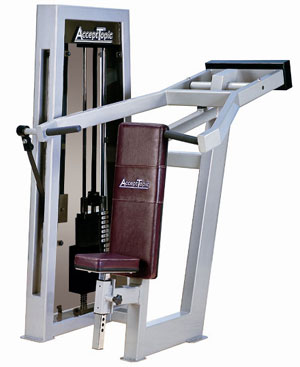|
How to Improvise a Shoulder Press Machine
Out of 2 Bars and a Power Rack
 The benefits of the shoulder press machine are many: improved shoulder strength and muscle mass, no need to kick dumbells up to your shoulders, increased stability, etc.
The benefits of the shoulder press machine are many: improved shoulder strength and muscle mass, no need to kick dumbells up to your shoulders, increased stability, etc.
But many gyms are sorely lacking when it comes to shoulder press machines. They may not have one at all or one that simply doesn't work well.
What would you say if I were to tell you that you can not only very easily make your own shoulder press out of common gym equipment, it actually works even better than machines specifically designed for shoulder pressing!
How To Build It:
In order to build this, you'll need two Olympic Bars (one bar will do if you don't have two but you'll then you'll have to do the exercise one arm at a time), a power rack and some weight plates. Nothing fancy here.
Essentially, you'll be using the two bars, set inside the rack, as levers. You'll be outside the rack to either the left or right side, facing in, pushing up on the ends of the two bars as though they were the handles of a machine.
To maximize the effectiveness of this exercise, we'll need a rather specific setup. Once you know how to set the exercise up, you'll find it's just as quick as any other rack exercise setup.
Start by setting a flat bench beside the rack, with the end about a foot from the side of the rack. This is what you'll be sitting on as you do the exercise. Next, we'll be setting the height of your safety rails in the rack. The height will vary somewhat, depending on how tall you are.
Sit on your bench, facing the rack, and set the safety rail right in front of you to a little above your shoulder height. The other safety rail should be set about 2 feet higher than this rail. Having the other end higher is necessary for proper and safe functioning of the movement. The two Olympic bars should not go much higher than horizontal at the top of the movement. This is especially important if the safety rails on your rack are smooth metal. If the bars go higher than horizontal, you may end up sliding them forward rather than up.
Set the two bars on the rails in the rack, about shoulder-width apart (approximately 2 feet). They will be angled down towards the bench at about a 35 degree angle.
In order to ensure that the bars don't slide, pull the collars of the bars against the top safety rail. I also highly recommend putting a 10 pound weight plate on the ends with a collar to toally eliminate the possibility of the bar slipping down.
 Do a practice rep without any weight plates on the lower ends to make sure the setup feels good. Sit on the end the bench and place the heels of your hands under the ends of the two bars. Now wrap your fingers around the ends of the bars. You may have to lift the bars up a little to get into the start position.
Do a practice rep without any weight plates on the lower ends to make sure the setup feels good. Sit on the end the bench and place the heels of your hands under the ends of the two bars. Now wrap your fingers around the ends of the bars. You may have to lift the bars up a little to get into the start position.
Perform a shoulder press movement from there. Start with your hands in the normal shoulder-width position. As you press up, bring your hands together overhead in an arc.
This freedom of movement is one of the most valuable benefits of this set-up. Most machines don't allow you to do this--they lock your hands into position like a barbell, increasing the stress on your shoulder joints.
Dumbells do allow this freedom of movement but it's very difficult to get very heavy dumbells up into position. With this exercise you get the best of both worlds...the ability to use more weight, like a machine, and the increased freedom of movement like dumbells.
Now it's time to add some weight to the bars. Use smaller sized plates (5, 10, and 25 pounders, at the most) so you don't bang them together at the top. If the plates are larger, you won't be able to bring them together as close, which will limit the effectiveness of the exercise.
Start adding weight conservatively - remember, you're also lifting the weight of the bars as well.
It is EXTREMELY important that you use very solid collars on the bars on the lower ends. The bars are at a steep angle and the potential for the weights to slide off is great. Check for signs of slippage between sets (gaps between the weight plates and the bar collars).
Perform the seated shoulder press as you normally would on a machine. You've now got yourself a shoulder press machine!
Why This Exercise Is So Effective:
As I mentioned above, one of the major benefits of this setup is the freedom of movement you get with the bars. Unlike machines and like dumbells, you are able to bring your hands together at the top of the movement.
Another advantage of this setup over a regular machine or barbell is the independent movement of the bars. This eliminates the problem of the stronger side helping out the weaker side too much and creating strength imbalances. It also allows you to perform both one arm presses and alternating arm presses very easily.
The possibility of using more weight, like a barbell or machine, without having to get those weights up to shoulder position on your own power, like with dumbells, is a tremendous advantage as well.
Conclusion:
A good shoulder press machine is hard to find. Why not build your own machine that actually works better! All you need is a couple of bars and a rack.

More Articles by Author Nick Nilsson
Return To Weight Lifting Articles Archive
|